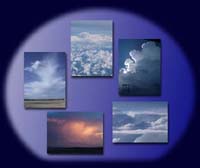|
ScUndulatus1-6.jpg:
These are the clouds which produce a drizzle called "Garua"
in South America. In the tropes near Galapagos there are only two
seasons known: the cold dry season (June till November) and the
warm, humid rain season (January till June) with transition periods
up to eight weeks in between. In the dry season the major sea flow
is the south equatorial flow, which is directed orthogonally to
the South-American coast towards Japan. The major wind in this season
is the Southeast trade wind. The sea surface temperature varies
between 16 and 28 degC.
In the dry season the cold south equatorial flow meets the warm
tropical air. This causes the builtup of an inversion layer at an
altitude between 200 and 600 m where the humid air cooled by the
sea is located below the warm tropical air. Since there is no vertical
exchange, uniform Stratus translucidus, sometimes Stratus opacus
clouds are formed at the inversion base above an altitude of 200
m. At the elevations of the islands the vegetation is similar to
rainforests which can survive because of this drizzle and fog, whereas
at altitudes below 200 m only dry vegetation is found.
The trade winds weaken starting in December and the South equatorial
flow will be over-shadowed by the Panama flow coming from the North
along the South-American coast. This is a warm flow, which accordingly
heats up the air so that the inversion layer disappears and the
usual tropical Cumulus clouds with their strong precipitation can
form. Now also the plants of the dry zone are able to ingest water.
|
The image "Hay barn at a wet day" created by Vincent
Van Gogh presents a Stratocumulus cloud layer with wave-like structure.
Most probably it was painted in 1890 in Saint-Remy. Today it is
exhibited in Rijksmuseum Kröller-Möller in Otterloo, The
Netherlands.
ScUndulatus5.jpg:
This cloud layer can be exactly classified as "Stratocumulus
stratiformis undulatus opacus", since the sun can not be noticed
through the compact cloud cover. The two other ones could be also
named as "translucidus".
ScUndulatus6.jpg shows the Stratocumulus cloud cover. The image
was taken from an aircraft located above the island Santa Cruz.
Here the undulatus-like structure can be better noticed. The Garua
clouds dissolved later in the morning, but they could also exist
for several days.
ScSpace.jpg:
This picture shows a view from the Space Shuttle onto the Galapagos
region. It is described as followed: "Cloud shrouded volcanoes,
Galapagos Islands. This photograph shows how clouds hang at a precise
altitude. Volcanic peaks on the Galapagos islands rise above the
cloud layer. The circular volcanic summits visible in the picture
highlight both the classical conical shape of the volcanic structures
and the stability of the cloud altitude. The radiating fan pattern
in the cloud around the volcanoes is caused by downslope winds.
The equatorial location of the islands contributes to the uniformity
of the cloud around the volcano summits. Similar phenomena have
been seen on the Martian atmosphere..... " The image clearly
shows that the upper limit of the Garua clouds only exist in a single
altitude range.
|
Marsclouds.jpg: Here also an example from the Martian atmosphere.
Shown is a cloud cover similar to the one around the top of the
"Olympus Mons". This is a shield volcano, which has an
altitude of 27 km and is therefore the highest elevation in the
solar system. It is often surrounded by layers of thin clouds, which
only occur in a certain altitude range.
ScUndulatus1.jpg: S. Borrmann, Volcano Cone on the Island Santa
Cruz, Galapagos, September 2000
ScUndulatus2.jpg: S. Borrmann, Island Wolf (Culpepper), Galapagos,
September 2000
ScUndulatus3.jpg to ScUndulatus6.jpg: S. Borrmann; near the Island
Darwin (Wenman) with view to the North, Galapagos, September 2001
Scspace.jpg: Pat Jones, Shuttle
views the Earth: Clouds from Space, 1989.
Marsclouds.jpg: Heuseler, H., R. Jaumann und G. Neukum, The Mars
Mission, BLV, 1998; also (Planetary Photo
Journal of NASA Jet Propulsion Laboratory) Copyright: NASA
Enigma del Lago: Mural painting in Arcumeggia located near the Lago
Maggiore, Northern Italy 19 August 2004, 4:23 p.m.
Vincent van Gogh, "Hay barn at a wet day", Oil painting,
64 cm x 52.5 cm, 1890 (?), Rijksmuseum in Otterloo, Netherlands
|
![]()











